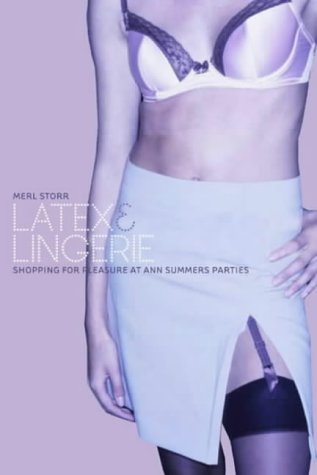Latex and Lingerie: Shopping for Pleasure at Ann Summers Parties
Merl Storr
Berg: Oxford
2003
185973698X (pb); 1859736939 (hb)
£14.99 (pb); £45.00 (hb)
xii + 235
 Latex & Lingerie is the first study of its type in that it investigates how (mainly white, 'working class') female (hetero)sexuality is played out through Ann Summers' parties. It is a fascinating account of a phenomenon that is commonly seen to be "inauthentic and tacky . [but] not sleazy enough" (p. 211). But, as Storr argues, "the sheer numbers of women involved seem to suggest that scholars of gender and sexuality should be taking Ann Summers rather seriously" not least because of the "pleasure and play, but also intense power struggles over heterosexual femininity, racked by identifications, exclusions, hierarchies, and (self-)policing" (p.2). However, Storr found no previous work on the subject.
Latex & Lingerie is the first study of its type in that it investigates how (mainly white, 'working class') female (hetero)sexuality is played out through Ann Summers' parties. It is a fascinating account of a phenomenon that is commonly seen to be "inauthentic and tacky . [but] not sleazy enough" (p. 211). But, as Storr argues, "the sheer numbers of women involved seem to suggest that scholars of gender and sexuality should be taking Ann Summers rather seriously" not least because of the "pleasure and play, but also intense power struggles over heterosexual femininity, racked by identifications, exclusions, hierarchies, and (self-)policing" (p.2). However, Storr found no previous work on the subject.
The book is divided into five chapters: (1) Introducing Ann Summers; (2) 'The Ultimate Girls' In'; (3) Objects of Desire; (4) Feminine Bodies, Feminine Pleasures; (5) Classy Lingerie.
The research was undertaken through participant observant over five months attending meetings and parties, and through fifteen semi-structured interviews. As Storr points out, such a relatively small number of women is not representative of the sales force as a whole but "the interviewees 'represent' only themselves" (p.14). Nonetheless, the interview data provides Storr with rich data with which to examine her themes.
Storr found that the tendency was towards tightly controlled gender identification ('being one of the girls') in contexts of very specific homosocial behaviours. For example, when asked which sexual position they prefer, being on top or underneath, the women overwhelmingly respond with the same loud 'post-feminist' response of "on top" (p.217). One woman who admits to preferring being dominated sexually is treated with puzzlement as she places herself deliberately out of the confines of the gender identification with the other 'girls'. Similarly, Storr found that there was concern about the stigma surrounding Ann Summers' parties, that women often found that the assumption was that they were 'dirty' if they were associated with Ann Summers. There was an ambivalence between getting points for sexual knowledge in the party games played and the need to defend oneself against being a 'slag' for running or attending the parties (pp.202-3). Despite its reputation Ann Summers relies on gendered 'family' systems, where women are recruited by family and friends, and employees have 'mums' who recruited or trained them.
While the book provides a strong account there were times that I felt quite uncomfortable. Storr admits that her own education and sexuality set her apart from the women she observed and interviewed, and that she chose to remain opaque to them in this regard, and not reveal particular information about herself to her participants in case it affected how they responded to her. She admits to feeling 'different' to them, more middle-class, and implies that her own tastes are now 'superior' (her mother and sister have been involved with Ann Summers in the past and only her University education prevented her following that route herself). The fact that she admits to this type of snobbery goes some way to easing the disquiet but, nonetheless, I felt that the withholding of information exacerbated the power imbalance between researcher and researched.
However, these comments should not detract from what is an interesting and important book, which examines a hugely successful homosocial phenomenon and raises crucial questions about gender, sexuality and class.
Samantha Holland
Leeds Metropolitan University

